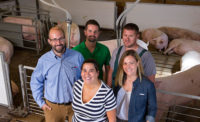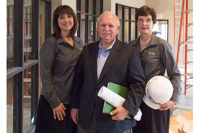
It’s the ideal blend of tactics and meat processing, where military tradition meets retail meat-case strategy.
To the typical passer-by, the Central Meat Processing Plant on Ramstein Air Force Base in Kaiserslautern, Germany, looks like just another administrative building, partially hidden by tall trees and shrubbery.
But to those who work in the plant or for the Defense Commissary Agency (DeCA) Europe, it is a hidden gem of an operation, quickly and quietly pumping out 920,000 pounds a month of further-processed beef and pork products to be shipped out to military commissaries and soldiers in the field across Europe and parts of the Middle East.
It also is the crown jewel of the DeCA efforts to support the troops in Europe, as no other branch of DeCA anywhere in the world can count such a plant as its centerpiece of production.
The Central Meat Processing Plant, or CMPP, is a picture of cleanliness and efficiency, meeting the highest standards of food safety. Built in 1998, the plant accommodates DeCA Europe’s complete switch to the vacuum package in its search for extended shelf life and compliance with its ever-stricter HACCP plan. Constantly seeking to streamline, it recently underwent a shift to a computerized, Internet-based tracking and ordering program.
“In the beginning, we got orders by faxes,” Arno Franke, commissary management specialist for CMPP, says. “And we’d sit here and write out the cutting lists by hand, on paper. Then we’d hand them out in the morning to the meat cutters.”
The challenge was to improve the speed and efficiency of the process, says Eddie Auld, deputy manager of CMPP.
“At that time, in 1998, there were more than 60 commissaries and a group of small Navy stores we supported,” he explains. “So how were we going to get that order information to this plant in a more efficient way?”
The solution was a state-of-the-art order-management system that the agency has been using for several years now, which really revolutionized CMPP’s work efficiency.
“The information comes in over the Internet, gets transferred into the computer and is uploaded,” Auld continues. “Different cut lists are then sent out to each department telling them exactly how much they need for each commissary every day.”
Band of brothers
While CMPP employees were very efficient prior to the new system’s launch, the order-management program has made them that much better, Auld explains.“One of the big differences you can see from then to now is, back then, fill rates were in the neighborhood of 85-86 percent,” he says. “Now, if we’re less than 100 percent on our fill rates, people are asking what happened and who dropped the ball. We can track orders from start to finish and have better visibility on quantities ordered for all our line items. This gives us terrific information for both historic and planning purposes.”
David Costello, CMPP plant manager, concurs that the system has helped motivate employees to strive to perfection and keeps them engaged on their performance.
“Every day, the actual employees wanted to know how we did from the day before, so we post a fill rate every day for them to see,” Costello says. It was a concept, he adds, that the management team introduced about seven years ago, and employees began to respond to it, particularly when fill rates were not 100 percent.
“They would question what we missed and where we went wrong,” he says. “Once we [introduced] that, it seemed as though, overnight, our fill rates started going from 89-90 percent up to 100 percent just about every day.”
It’s a teamwork-based culture that has allowed the plant to be flexible in its production capabilities. For example, currently, CMPP is capable of producing 126 different line items —76 beef items and 50 pork items. Of those 126 items, 17 are either dry-spiced or marinated items. All are vacuum-packed and shipped to DeCA commissaries, Navy NEXMARTS and Army Air Force Exchange sites around Europe and in the field via the DeCA-owned distribution network. Gerri Young, public affairs officer for DeCA Europe, says it was an “absolute plus” when DeCA took over the distribution system from the Defense Logistics Agency a number of years ago, allowing DeCA to own every portion of the system in Europe.
“Not only do we have our own meat plant (the CMPP), but we own two distribution centers and contract with commercial carriers to move most of the product. Some product does go by military air,” Young explains. “So we have, across the board in all of our commissaries, a much higher fill rate and stock rate than the state-side stores do.”
Close to the CMPP is DeCA’s Kaiserslautern Cold Storage (KCS) facility, located down the road adjacent to Ramstein Air Force Base. The KCS facility is nearly 50 years old, and comprises eight giant refrigerator/freezer warehouse rooms with a staff that receives, stores and ships more than 5 million cases of perishable products annually to 89 customers in 22 countries throughout Europe, Asia and Africa (in addition to supplying commissaries, over 40 embassies are supported). Its footprint covers approximately 205,000 square feet and the facility is capable of stocking 3,000 tons of frozen products and 2,400 tons of chilled products.
Because the distribution network is so streamlined, the biggest challenge CMPP typically has is receiving product. CMPP is not a slaughter facility, so it imports hard-chilled U.S. beef via ocean freight. Pork is supplied fresh by a German processor, and a second processor is available when needed. As expected, myriad situations can arise to threaten a delay in product, but contingency plans including emergency airlifting of product are possible if the plant gets in a real bind.
“If there’s a storm out at sea, it’s going to be delayed,” Auld says. “When the port authorities decide they’re going to inspect a container, or documentation with a container is inaccurate, … that could delay our product. But we keep a week and a half to two weeks worth of supply on hand for just that type of thing. So very rarely have we actually run out of any product.”
Safe and secure
CMPP and its suppliers have recognized that food safety and security, particularly on an international stage, are of key concern with their product, and Auld says they’ve taken every precaution to keep product safe during the long trip across the Atlantic Ocean.“There’s so much we do as far as food safety and how the product is handled coming to us, across the water,” he says. “The container it’s in is sealed when the product is first put in it. A 60-day tracking device is placed inside to record temperatures all the way across the ocean, and the container is not opened until our food inspector or a customs inspector at the port opens it.”
Yet, the concern over food safety doesn’t end once the subprimals arrive at CMPP. Food safety and food-safety training is of utmost concern at the plant level as well, Auld adds.
“All employees have to go through HACCP training when they first come on board, and then they have mandatory annual training. DeCA is big on training,” he explains. “Every quarter, we do a safety training with all of our employees. We’re always training safety, security, food security and food vulnerability.”
Costello adds that, as a facility regulated by the USDA, CMPP must be up to the standard or better on its food safety programs. He says the plant’s HACCP plan revolves around two points currently: purchase from approved sources and temperature. Within months, Costello adds, the plan will include a third point.
“Another point we’re getting ready to add will be metal detection, once all the metal detectors are up and running,” he says. “So we’ll go from two critical-control points to three. [The HACCP plan] is being monitored on a daily basis by our QA inspector, who has a 96-point checklist he has to follow every day to make sure we’re doing the steps that we need to be doing.”
CMPP’s safety and security measures also answer to the higher authorities in the military as well.
“DeCA Europe has its own U.S. Army food safety officer who regularly inspects the plant, but that is just the beginning,” Costello says. “Because we’re on an Air Force facility, we get monthly inspections by a public health officer from the air base, and that’s a no-notice inspection, where they can walk in anytime they want into our facility and do a full-blown audit-type inspection. Then, every six months, we have an auditor come out from the Army who is usually ranked captain or above, and they’ll do a full-blown audit also.”
Operation: Customer
CMPP benefits from DeCA’s ownership of most of the supply chain in product-development ventures as well. Because DeCA owns the commissaries, CMPP has first-hand access to the customers in the stores and their thoughts and opinions on products. New items are extensively sampled in the commissaries, and then sales figures of that item are examined.“Most of the time when you go out and sample, they say, ‘It’s free? Yeah, yeah, it’s good,’” Franke explains. “But then, after that, will they buy it? So we watch that — we watch how much sells. That gives us the result that, yes, it’s a good new product.”
Additionally, Franke has gone to German markets where American consumers shop to study what they’re buying there because they maybe cannot get it at the commissaries. He found Americans buying spiced and marinated products in those stores.
“So I came back to Mr. Costello and said, ‘Why do they have to go to the German store to buy spiced spare ribs or spiced pork chops? We can do it on our own and keep our customers in our store,’” he concludes. With that, DeCA’s spiced/marinated products were developed.
Another trend Franke has noticed, that CMPP and DeCA have explored, is the convenience trend.
“Nobody likes to stay for three or four hours in the kitchen after work, so we make something easy like stir fry,” Franke says. “They can put it in the frying pan, take a quick shower and be ready to eat when they come out.
“Many of our soldiers have a little kitchen in their rooms," he adds. "Sometimes they’re tired of the fast food or the mess hall and they want to make something themselves. Or, they’ll be planning a unit barbecue, so they can get our spiced products in bulk and enjoy something special without having to do so much work themselves.”
It’s that access that has CMPP ready to turn on a dime when necessary to meet the needs of its target customers.
The meat-processing operation at DeCA Europe went through many changes over the years, yet change isn’t always easy, as many processors know. Take, for instance, the overhaul to vacuum packaging for its entire line of beef and pork.
From tray-pack processed in the stores to the modern vacuum package, innovation and teamwork was the catalyst for the launch and subsequent success of the switch.
While the experts agreed the vacuum pack was the way to go, selling the idea to commissary customers used to the old ways was a tough job, says Young.
“The stores had meat cutters behind the counter, a butcher customers could walk up to and request whatever cut they wanted and get service very quickly. That was a big deal,” she says. DeCA took its time and was able to work with most of the meat cutters to offer them a reasonable solution — either retirement, move to working in the meat plant or another job elsewhere in the grocery system. Over time, even the “old school” meat cutters have come to believe in the modern package.
Today, with countless promotional and educational efforts, DeCA’s vacuum-packed items have gained excellent acceptance across all American military communities in Europe. The customers have more selection and availability than ever before — even in remote locations. Special orders and cuts are still accepted, requiring only a little advance planning, and the quality of the product is excellent, as demonstrated by high sales and customer feedback.
Those products provide a great example of how an organization such as the CMPP, though relatively small and tucked away on an Air Force base in Germany, has become successful enough to draw customers in to DeCA’s commissaries, but flexible enough to meet their oft-changing product demands.






